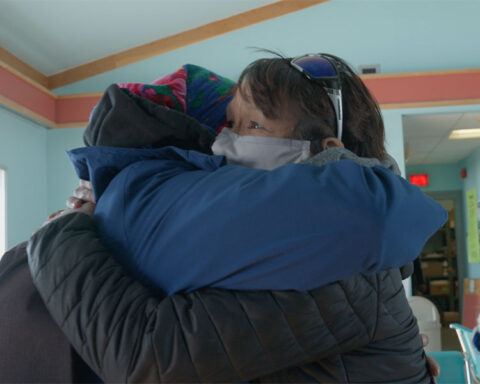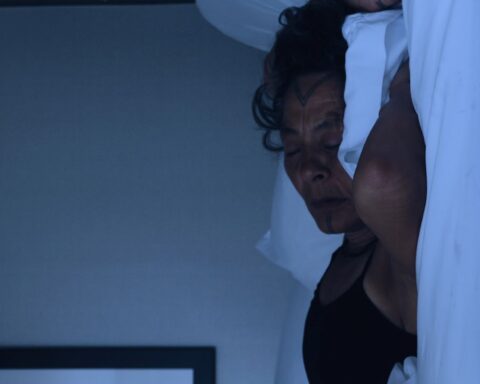Atautsikut, Leaving None Behind
(Canada, 60 min.)
Dir. John Houston
How do communities de-colonize? How do people free themselves from economic oppression? What happens when they succeed?
In John Houston’s new film, Atautsikut, Leaving None Behind, the story of how the Inuit of Nunavik embraced a cooperative movement that changed their lives is skillfully recounted. In community after community, they invested in themselves and their neighbours and eventually created locally run businesses – commercial fisheries, fuel supplies, craft productions as well as retail – that employ their own people. The cooperative movement is shown, through sympathetic interviews by Houston of the region’s elders, to have transformed the economy and, just as importantly, the psychology of the Inuit in this starkly beautiful area of Northern Quebec.
Traditionally, the Inuit of Nunavik lived exclusively off the land and the water. They hunted caribou and seal and caught fish. They wore polar bear skin clothing while building iglus and used qulliqs for heat and light. For centuries, they organized themselves into camps, a few families living together and supporting each other’s survival.
That changed when the first Europeans to have extensive contact with them, the Moravian missionaries and traders, arrived in the early 1830s. Inevitably, as was the case across the Canadian North, the Moravians were followed by the representatives of the Hudson Bay Company (HBC). The former brought Christianity; the latter brought sugar, guns and other trade goods.
By the mid 20th Century, not much more had changed for the Inuit. The HBC still profited from the Inuit’s production, and threatened to move any employee who wanted to help the local people out of poverty. The hunters were being exploited brutally by the HBC, who grossly underpaid the people of Nunavik for the seals, bears, caribou and fish they bought from them. Sometimes, when times were tough, the Inuit were allowed to starve to death by the company, which was making huge profits from them. Finally, in the 1950s, three men, sent respectively by the Church, the HBC and the Government of Canada, encouraged the Inuit to forge a different path and gave them the tools to do so.
John Houston, whose father James was one of the men who helped to develop the Inuit economy, was deservedly commissioned by the Fédération des coopératives du Nouveau-Québec (FCNQ) to make Atautsikut, Leaving None Behind. Houston was raised in Cape Dorset and speaks fluent Inuktut and remembers many of the people who came to Nunavik to introduce the concept of co-ops. The filmmaker’s relationship to the people, and their ease with him, is obvious not only in the Inuktut interviews he conducts, but in the ease in which he is treated by these reserved people. In scene after scene, Houston brings photographs and works of art back to the communities to share them with the descendants of the artists. The elders and the younger members of those villages and towns are clearly charmed and moved to see these pieces, many of which had never been seen since they were sold or taken down south decades earlier.
The oppression of the HBC period is well documented in films. Houston makes excellent use of footage gathered from the wealth of documentation held by the Archive of the Hudson Bay Company in Winnipeg, as well as from national institutions such as the National Film Board and the CBC/Radio-Canada. Nanook of the North is even excerpted. The Inuit (and Cree) knowledge-keepers explain how the furs were paid for at the lowest possible price, while the additional work to turn the skins into valuable items was completed elsewhere, and the eventual profits were reinvested far away, not in the communities of the hunters themselves.
John Houston’s father James, an artist and an associate of the Canadian Handicrafts Guild, spent much of 1948-1950 in the region, identifying and developing Inuit artists, enabling them to become more economically self-sufficient. Through his encouragement, Nunavik became an important site for carving. In John’s film, the story of the development of the region’s artists is an important part of the documentary’s narrative, which concerns itself with the creation and maturation of the co-op movement.
It all started with the artists and craftspeople in Nunavik back in the late Forties. James Houston demonstrated to the local men what to carve, by cutting out the shape of a bird. But the carvers said they didn’t have the right kind of stone. They eventually took so many pieces out of a woman’s soapstone lamp (qulliq) that it was entirely used up! Each carved piece was purchased by Houston and eventually others, which allowed the people to buy food for immediate use. Soon after, Peter Murdoch ignored the instructions of his employer, the HBC, and opened savings accounts to allow the people to put away 5% of their earnings (a little beaver nickel was used to illustrate the concept). He showed them how those ‘little 5 cents’ could turn into a fishing boat, or other tools. Qallunaat (white people) may have provided information and tools, but the concept of mutual aid, and leaving none behind, was familiar to people who relied on each other to survive.
Though white settlers like James Houston and Peter Murdoch and Father André Steinmann helped to start the Inuit on the path towards a co-operative movement, the film makes it clear that it was the natives of the region who slowly but surely built up a new economy and local political structure in Nunavik. As the movement became more successful, with the individual co-operatives federating as the FCNQ, Nunavik began to receive delegations from other regions, most notably from the artists at Cape Dorset. The FCNQ has become so renowned that they were invited years ago to Chile to explain to indigenous communities how to build their own federation of cooperatives. Archival footage in Houston’s film shows the delegation being treated as experts and important visitors.
Atautsikut is very well structured, taking audiences through the evolution of Inuit in northern Quebec from the ‘stone age,’ as one Inuk says, through to building enormous operations that supply the entire region. The archival film footage, along with Houston’s father’s photographs and drawings and a few animations, take us from a caribou-skin wearing Inuit through to the celebration of the 50th anniversary of the FCNQ in a modern banquet hall.
John Houston was clearly impressed by what he saw as he travelled among the communities of Nunavik to meet with the leaders of the coop, both present and past. “I think the genesis of Nunavik co-ops could be a revelation and an inspiration to the people of Nunavut, where co-ops could be seen more as a chain of stores and less as a movement,” he wrote to POV. “Co-ops are taken very seriously in Québec!”
Indeed, Nunavut—and the Aboriginal Peoples Television Network (APTN)—should see and show Atautsikut, Leaving None Behind. And they aren’t the only ones. Why hasn’t the CBC purchased this film? John Houston’s doc tells an important story about the positive influence of co-ops in Nunavik. Surely there are others apart from those in Nunavik who could benefit from seeing this tale of a great Canadian success, organized and managed by the Inuit. Houston has crafted a truly worthy Canadian documentary.
Atautsikut, Leaving None Behind is available on DVD and Blu-ray.











